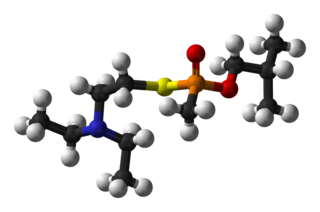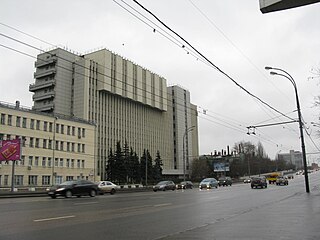Nerve agents, sometimes also called nerve gases, are a class of organic chemicals that disrupt the mechanisms by which nerves transfer messages to organs. The disruption is caused by the blocking of acetylcholinesterase (AChE), an enzyme that catalyzes the breakdown of acetylcholine, a neurotransmitter. Nerve agents are irreversible acetylcholinesterase inhibitors used as poison.

VX is an extremely toxic synthetic chemical compound in the organophosphorus class, specifically, a thiophosphonate. In the class of nerve agents, it was developed for military use in chemical warfare after translation of earlier discoveries of organophosphate toxicity in pesticide research. In its pure form, VX is an oily, relatively non-volatile liquid that is amber-like in colour. Because of its low volatility, VX persists in environments where it is dispersed.
Binary chemical weapons or munitions are chemical weapons which contain the toxic agent in its active state as chemical precursors that are significantly less toxic than the agent. This improves the safety of storing, transporting, and disposing of the weapon. Commonly, firing the munition removes a barrier between two precursors. These react to form the intended agent which is then aerosolized and distributed by a bursting charge.

VG is a "V-series" nerve agent chemically similar to the better-known VX nerve agent. Tetram is the common Russian name for the substance. Amiton was the trade name for the substance when it was marketed as an insecticide by ICI in the mid-1950s.
Novichok is a family of nerve agents, some of which are binary chemical weapons. The agents were developed at the GosNIIOKhT state chemical research institute by the Soviet Union and Russia between 1971 and 1993. Some Novichok agents are solids at standard temperature and pressure, while others are liquids. Dispersal of solid form agents is thought possible if in ultrafine powder state.

VR is a "V-series" unitary nerve agent closely related to the better-known VX nerve agent. It became a prototype for the series of Novichok agents. According to chemical weapons expert Jonathan Tucker, the first binary formulation developed under the Soviet Foliant program was used to make Substance 33, differing from VX only in the alkyl substituents on its nitrogen and oxygen atoms. "This weapon was given the code name Novichok."

Cholinesterase inhibitors (ChEIs), also known as anti-cholinesterase, are chemicals that prevent the breakdown of the neurotransmitter acetylcholine or butyrylcholine. This increases the amount of the acetylcholine or butyrylcholine in the synaptic cleft that can bind to muscarinic receptors, nicotinic receptors and others. This group of inhibitors is divided into two subgroups, acetylcholinesterase inhibitors (AChEIs) and butyrylcholinesterase inhibitors (BChEIs).

EA-3148 is a "V-series" nerve agent related to the better-known compounds VX and VR. It was studied by both the US and Soviet chemical weapons programmes during the Cold War, and is notable as the only V-series organophosphate nerve agent specifically identified in public domain sources as having a higher absolute potency as an acetylcholinesterase inhibitor than VX. However, both the US and Soviet investigations of the compound concluded that despite its high potency, the physicochemical properties of the substance made it unsuitable for weaponisation, and further research was not conducted.
Vil Sultanovich Mirzayanov is a Russian chemist of ethnic Tatar origin who now lives in the United States, best known for revealing secret chemical weapons experimentation in Russia.

The poisoning of Sergei and Yulia Skripal, also known as the Salisbury Poisonings, was a botched assassination attempt to poison Sergei Skripal, a former Russian military officer and double agent for the British intelligence agencies in the city of Salisbury, England on 4 March 2018. Sergei and his daughter, Yulia Skripal, were poisoned by means of a Novichok nerve agent. Both spent several weeks in hospital in a critical condition, before being discharged. A police officer, Nick Bailey, was also taken into intensive care after attending the incident, and was later discharged.

A-232 is an organophosphate nerve agent. It was developed in the Soviet Union under the FOLIANT program and is one of the group of compounds referred to as Novichok agents that were revealed by Vil Mirzayanov. A-232 is reportedly slightly less potent as a nerve agent compared to some of the other compounds in the series such as A-230 and A-234, having similar potency to the older nerve agent VR. However it proved to be the most versatile agent as it was chemically stable and remained a volatile liquid over a wide temperature range, making it able to be used in standard chemical munitions without requiring special delivery mechanisms to be developed.

A-234 is an organophosphate nerve agent. It was developed in the Soviet Union under the FOLIANT program and is one of the group of compounds referred to as Novichok agents that were revealed by Vil Mirzayanov. In March 2018 the Russian ambassador to the UK, Alexander Yakovenko, claimed to have been informed by British authorities that A-234 had been identified as the agent used in the poisoning of Sergei and Yulia Skripal. Vladimir Uglev, one of the inventors of the Novichok series of compounds, said he was "99 percent sure that it was A-234" in relation to the 2018 Amesbury poisonings, noting its unusually high persistence in the environment.
Chemical weapons have been a part of warfare in most societies for centuries. However, their usage has been extremely controversial since the 20th century.

On 20 August 2020, Russian opposition figure and anti-corruption activist Alexei Navalny was poisoned with a Novichok nerve agent and was hospitalized in serious condition. During a flight from Tomsk to Moscow, he became ill and was taken to a hospital in Omsk after an emergency landing there, and put in a coma. He was evacuated to the Charité hospital in Berlin, Germany, two days later. The use of the nerve agent was confirmed by five Organisation for the Prohibition of Chemical Weapons (OPCW) certified laboratories. On 7 September, doctors announced that they had taken Navalny out of the induced coma and that his condition had improved. He was discharged from the hospital on 22 September 2020. The OPCW said that a cholinesterase inhibitor from the Novichok group was found in Navalny's blood, urine, skin samples and his water bottle. At the same time, the OPCW report clarified that Navalny was poisoned with a new type of Novichok, which was not included in the list of controlled chemicals of the Chemical Weapons Convention.

A-230 is an organophosphate nerve agent. It was developed in the Soviet Union under the FOLIANT program and is one of the group of compounds referred to as Novichok agents that were revealed by Vil Mirzayanov. A-230 is possibly the most potent nerve agent for which specific toxicity figures have been published, with a human lethal dose estimated to be less than 0.1 mg. However it was felt to be less suitable for weaponisation than other agents such as A-232 and A-234, due to issues with the liquid agent exhibiting low volatility and solidifying at low temperatures, as well as poor stability in the presence of water.

A-242 is an organophosphate nerve agent. It was developed in the Soviet Union under the FOLIANT program and is one of the group of compounds referred to as Novichok agents that were revealed by Vil Mirzayanov. Mirzayanov gives little specific information about A-242, stating that it is highly toxic but no figures are given to compare it to other related agents. It is reportedly a solid rather than a volatile liquid as with most nerve agents, and in order to weaponise it successfully, it had to be milled into a fine powder form that could be dispersed as a dust.

The State Research Institute of Organic Chemistry and Technology (GosNIIOKhT) is a Russian research institute engaged in the development of chemical technologies for use in the national economy and the production of relevant goods and products.

Thiosarin, sulfursarin or GBS, is the organophosphorus compound analogous to sarin. It differs structurally in that sulfur replaces the oxygen of the P=O bond. It is an extremely toxic substance related to G-agents.













